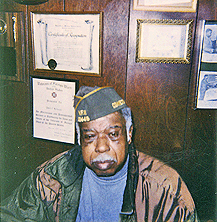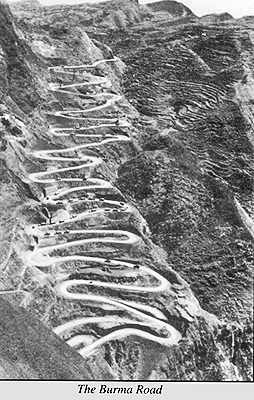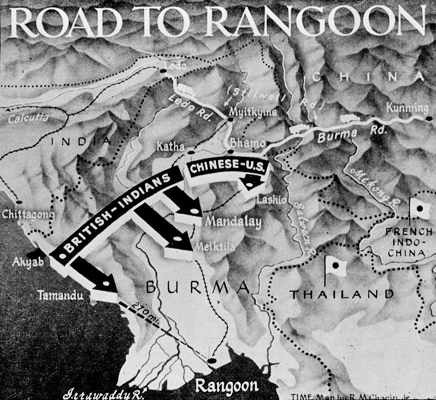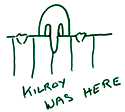The Stamford Historical Society Presents
Pride and Patriotism: Stamford’s Role in World War II
Online Edition
The Interviews
Robert MacDonald
Robert MacDonald joined the army in 1942 and was assigned to the 45th Quartermasters’ Trucking Regiment. After training in California, MacDonald was shipped to India, where he drove trucks supplying ammo, bombs, gasoline, food and even tanks to the allied front in Burma and China.
 I came to Stamford from North Carolina when I was seven years old. When WWII started, I as working at Alcoa Aluminum Co. in Fairfield manufacturing airplane parts. A number of my friends from Stamford were all going to the War and I got drafted in 1942. There were 26 Stamford black guys that went in with me and we all ended up in the same outfit. At the time I went in, the 9th and 10th Battalions were all black, since the army was segregated then. I went into a trucking regiment the 45th Quartermasters’ Truck Regiment and went to basic training at Camp Spellman, Pittsburg, California. I was stationed there 10 months. The troops were all black with white officers. After 6 weeks of Basic Training we were taught to drive trucks. The trucks were 6 x 6 and weighed 2 1/2 tons. We would get up at 6 AM and start training at 7:30. We would learn about the trucks as well as how to drive them. Some of the guys had driven trucks before and they served as instructors. We also had drills. I qualified on the rifle range for marksmanship. In California, we drove the trucks to different ports with supplies, to LA and to Long Beach mostly. We also drove Japanese-Americans to interment camps. They would have us drive at night in Southern California with an officer following in a jeep. The Japanese-Americans would only be allowed to take two suitcases with them. Some people would try to sell family heirlooms for nothing, while some younger people would rather smash items than sell them for the shame of it. I went in two or three of these convoys to move Japanese citizens. What was interesting is that in no time, these citizens had formed their own government in the camps with mayors, etc. There was one bad hill I remember, the “Grapevine” outside LA, we would have to select gears then gradually get down the hill. I was assistant driver the first time to get the experience of it.
I came to Stamford from North Carolina when I was seven years old. When WWII started, I as working at Alcoa Aluminum Co. in Fairfield manufacturing airplane parts. A number of my friends from Stamford were all going to the War and I got drafted in 1942. There were 26 Stamford black guys that went in with me and we all ended up in the same outfit. At the time I went in, the 9th and 10th Battalions were all black, since the army was segregated then. I went into a trucking regiment the 45th Quartermasters’ Truck Regiment and went to basic training at Camp Spellman, Pittsburg, California. I was stationed there 10 months. The troops were all black with white officers. After 6 weeks of Basic Training we were taught to drive trucks. The trucks were 6 x 6 and weighed 2 1/2 tons. We would get up at 6 AM and start training at 7:30. We would learn about the trucks as well as how to drive them. Some of the guys had driven trucks before and they served as instructors. We also had drills. I qualified on the rifle range for marksmanship. In California, we drove the trucks to different ports with supplies, to LA and to Long Beach mostly. We also drove Japanese-Americans to interment camps. They would have us drive at night in Southern California with an officer following in a jeep. The Japanese-Americans would only be allowed to take two suitcases with them. Some people would try to sell family heirlooms for nothing, while some younger people would rather smash items than sell them for the shame of it. I went in two or three of these convoys to move Japanese citizens. What was interesting is that in no time, these citizens had formed their own government in the camps with mayors, etc. There was one bad hill I remember, the “Grapevine” outside LA, we would have to select gears then gradually get down the hill. I was assistant driver the first time to get the experience of it.
After 10 months we were taking troops down to the boats. Long Beach, California. Finally we went on a boat as well, the George Washington, along with 7000 men. We were on the water for 45 days and finally docked at Bombay, India. We sailed alone and zig-zagged across the Pacific, we were not in convoy.
 Negro troops were not armed then on the boat. Our regiment was of 12 companies, with about 110 men to a company. We then got on a British boat that took us to Calcutta, India. In Calcutta we suffered our first casualty on Christmas Day, 1942. The Japs bombed the port of Calcutta and killed a man and wounded an officer. We then went by train to Ledo, India, a village at the beginning of the Ledo Road, which ran into the Burma Road. There we got more training in truck driving. Many of the engineering outfits were black also, and some were from Stamford in the 1883rd Engineers on the Ledo Road.
Negro troops were not armed then on the boat. Our regiment was of 12 companies, with about 110 men to a company. We then got on a British boat that took us to Calcutta, India. In Calcutta we suffered our first casualty on Christmas Day, 1942. The Japs bombed the port of Calcutta and killed a man and wounded an officer. We then went by train to Ledo, India, a village at the beginning of the Ledo Road, which ran into the Burma Road. There we got more training in truck driving. Many of the engineering outfits were black also, and some were from Stamford in the 1883rd Engineers on the Ledo Road.
The Burma Road was 1100 miles long and went all the way to Kunming, China. There were a number of mile markers along the road. It started at Ledo. Hell Gate was 33 miles along at the bottom of a mountain. Initially we would leave with a cargo of gasoline, rice, barley, ammo or equipment and leave in the PM to get to Hell Gate. From there the next stop was Logali, was the 56 mile mark. It would take 12 to18 hours to get there, to go 56 miles. That was because from the 33rd to 56th mark it was all up hill and the weather was often bad. You would have to put chains on the tires when it rained, especially during the monsoon season. We would stay overnight at Logali and sleep in the truck. There was a US Camp at Logali too. The next day we would go on to The Gap at the 90 mile mark. The trip again was uphill all day. Some of the turns were so sharp you would have to back up to go around them. Shimuang was at 126 miles and mostly downhill from the 90 mile mark. After that it was fairly level land in Burma and an easy drive. At one point we were carrying equipment for Merrill’s Marauders. When the road was cleared to China, we drove all the way to Kunming to bring tanks to the Chinese. We would drive Diamond T trucks that were like Mack trucks with the 13 ton tanks loaded on the back. I also drove British lorry trucks with the steering wheel on the right hand side.
Once we got stuck on the road. The Japanese had cut the road back to base off and the bridge was out in front for two weeks.
We did have air raids but I never saw any Japanese planes or troops.
On time off I went to Calcutta by railroad. People were dying at 1500 a day because of famine. The Black Red Cross was operating there with Marge Johnson of Stamford in charge. Malaria was rampant and we had to take Adebrine every morning so we wouldn’t get it.

“Road to Rangoon,” showing Ledo Road in relation to theatre of war.
This and more images can be found at World War II Timeline Pictures
University of San Diego History Pages.
Burma Road
Ledo Road (Stilwell Road)
U.S. Army Center of Military History:
Central Burma
Ledo Road
Road Builders
 Introduction
Introduction
Veterans
Battles
Stamford Service Rolls
Homefront
Exhibit Photos
Opening Day

